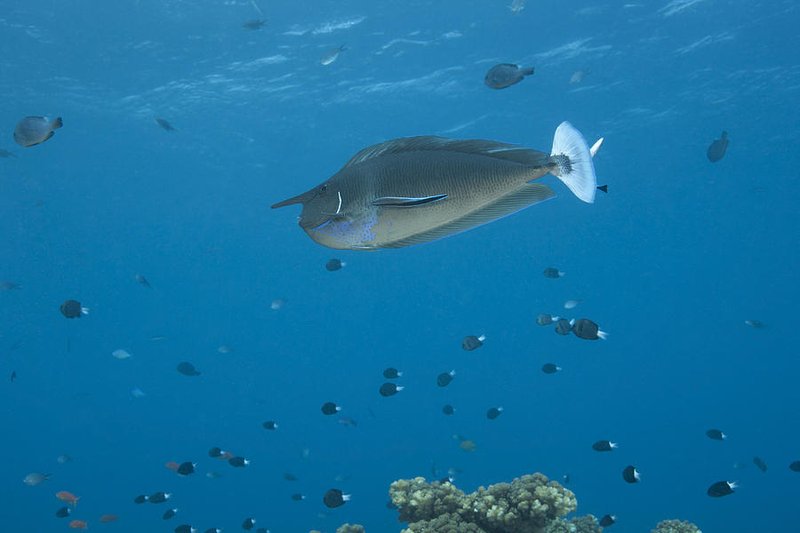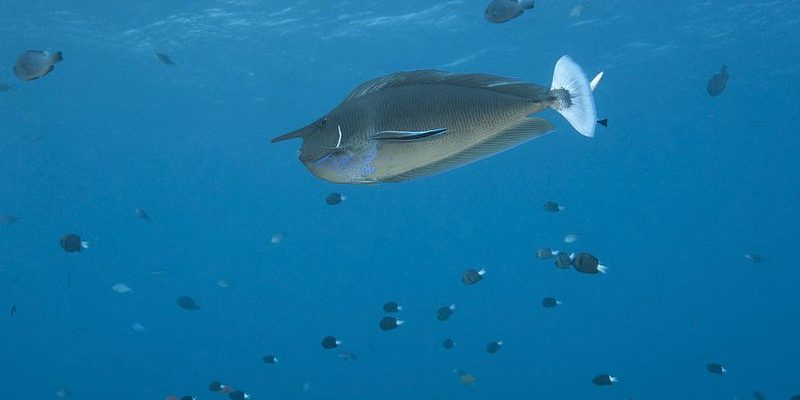
Picture this: you’re snorkeling in warm, turquoise waters, surrounded by vibrant coral reefs. As you take a closer look, you spot a fish that seems almost mythical—its body glimmering with shades of blue, yellow, and even green. This stunning creature is known as the unicornfish. With a distinctive horn on its forehead and a playful demeanor, unicornfish are truly fascinating inhabitants of the ocean.
While they might sound like they belong in a fairy tale, unicornfish are very real and captivating to observe. These marine animals belong to the family Acanthuridae, which also includes surgeonfish. With their unique shapes and colors, they not only enchant underwater explorers but also play a vital role in maintaining the health of coral reef ecosystems.
What Are Unicornfish?
Unicornfish are part of the surgeonfish family, primarily found in tropical and subtropical waters. The name comes from the characteristic horn-like projection on the males’ foreheads, resembling a unicorn’s horn. This horn is not just for show; it plays a role in mating displays and social interactions. The fish can grow to be around 15-30 inches long, depending on the species, making them noticeable during underwater excursions.
These fish are known for their lively personalities and social behavior. They typically swim in groups, exhibiting a playful nature as they dart around, interacting with one another. You might even catch them nibbling on algae and crustaceans off the coral, helping to keep the reef clean and healthy.
Physical Characteristics
Unicornfish are truly a sight to behold! Their bodies are typically oval-shaped, providing both agility and speed. The colors of unicornfish can range from bright blues and yellows to earthier tones, depending on the species and their environment. For instance, the Hawaii unicornfish boasts a vibrant yellow and blue demeanor that captivates many divers.
One of the standout features of unicornfish is their spines, which are sharp and pointed. Located on either side of their tails, these spines serve as a defense mechanism against predators. When feeling threatened, a unicornfish can quickly swim away or use its spikes to deter attackers. This combination of speed and armor creates a confident little fish in its vibrant world.
Habitat and Distribution
Unicornfish can be found in warm waters across the Pacific and Indian Oceans. They thrive in coral reef environments, where they can find ample food supply and shelter from predators. These reefs present colorful landscapes of coral and marine life, making them an essential habitat for unicornfish and many other species.
In terms of specific locations, you might spot them in places like the Great Barrier Reef in Australia or the reefs of Hawaii. They favor shallow waters where they can easily access food and socialize. However, as you go deeper into the ocean, their presence diminishes. This preference for shallower waters makes them easier targets for divers and snorkelers hoping to witness their beauty firsthand.
Diet and Feeding Habits
When it comes to eating, unicornfish are herbivores. Their diet primarily consists of algae, which they graze from coral reefs. Their specialized teeth are designed for scraping algae off hard surfaces, allowing them to find food where other fish may struggle. As they munch on algae, unicornfish play a crucial role in maintaining the balance of their ecosystem by preventing algae overgrowth.
In addition to algae, unicornfish may also consume the occasional invertebrate or zooplankton. This varied diet provides essential nutrients and energy for their active lifestyle. Watching them feed offers a fascinating glimpse into their behaviors and interactions with other marine life, as they often share feeding grounds with other fish species.
Behavior and Social Structure
Unicornfish are known for their social nature. They typically form groups, or schools, which provide safety in numbers. These schools can range in size from a few individuals to dozens of fish all swimming together. Within these schools, you may notice established hierarchies, with larger fish often asserting dominance. This social structure isn’t just about protection; it also plays a significant role in their breeding habits.
During mating season, males display their vibrant colors and even perform elaborate swimming displays to attract females. They may engage in playful nudging and darting to showcase their strength and fitness. This interaction is a vital part of their life cycle, as successful mating ensures the continuation of their species.
Conservation Status
While unicornfish are colorful and fascinating, they face threats from habitat loss and overfishing. Coral reefs are incredibly sensitive ecosystems. As temperatures rise and pollution increases, these habitats are declining, affecting the unicornfish populations that rely on them. In addition, due to their beauty and social behavior, unicornfish are often targeted for the aquarium trade.
Efforts are underway in various regions to protect coral reefs and manage fish populations sustainably. Marine protected areas have been established in some locations to help preserve the habitats that unicornfish call home. By promoting sustainable fishing practices and raising awareness about their ecological importance, we can work together to ensure that these enchanting creatures stay a part of our underwater world.
Interesting Facts About Unicornfish
| Common Name: | Unicornfish |
| Scientific Name: | Various species in the genus Naso |
| Size: | 15-30 inches (varies by species) |
| Diet: | Herbivore, primarily algae |
| Habitat: | Tropical and subtropical coral reefs |
| Behavior: | Social, often found in schools |
| Lifespan: | 10-20 years in the wild |
FAQ
What is the lifespan of a unicornfish in the wild?
Unicornfish typically live between 10 to 20 years in the wild, depending on the species and environmental conditions. In marine conservation areas where they are protected from overfishing and habitat destruction, they may even live longer, enjoying a stable habitat with plenty of food.
Are unicornfish aggressive towards other fish?
Generally, unicornfish are not aggressive by nature, especially towards smaller fish. However, during mating season or when defending their territory, they may display more assertive behavior. It’s fascinating to observe their social interactions—there’s often a pecking order within schools that can lead to playful nudging among individuals.
Can unicornfish change color?
Unlike some other species of fish, unicornfish do not have the ability to change color drastically. However, their color can become more vibrant when they are excited or stressed. Additionally, shifts in lighting or surroundings can make them appear slightly different, but this isn’t the same as the color-changing abilities seen in some other fish like cuttlefish.
Do unicornfish have any predators?
Yes, unicornfish face predation from larger fish, particularly sharks, and groupers. Their sharp spines serve as a deterrent, but they must still be cautious and maintain their social schools to avoid becoming an easy target.
How do unicornfish reproduce?
Unicornfish reproduce by spawning, which usually occurs in groups, where males and females release their eggs and sperm into the water column simultaneously. This method increases the chances of fertilization. After the spawning event, fertilized eggs float to the surface, where they hatch into larvae that eventually settle on the reef.
Where can I see unicornfish in the wild?
If you’re eager to witness unicornfish in their natural habitat, consider planning a trip to popular snorkeling or diving destinations like Hawaii or the Great Barrier Reef. Local marine reserves and protected areas often provide the best opportunities to see these enchanting creatures up close.
Are unicornfish popular in the aquarium trade?
Yes, many aquarium enthusiasts find unicornfish appealing due to their vibrant colors and social behavior. However, collecting them from the wild can contribute to population declines, so it’s important to acquire them from reputable sources that prioritize sustainable practices and breeding.
How can we help protect unicornfish and their habitats?
You can help protect unicornfish by supporting sustainable fishing practices, participating in local reef clean-up efforts, and advocating for marine protected areas. Raising awareness about the challenges facing these fish and their habitats can also encourage sustainable tourism practices, ensuring that future generations can enjoy witnessing unicornfish in the wild.
What is the significance of the unicornfish in marine ecosystems?
Unicornfish play a crucial role in maintaining the health of coral reef ecosystems by grazing on algae, which helps prevent algae overgrowth that can suffocate corals. Their presence contributes to the overall biodiversity of reef environments, making them vital players in marine health.
Do unicornfish have any special adaptations for their environment?
Yes, unicornfish have evolved several adaptations to thrive in coral reef habitats. Their body shape allows for quick swimming, which is essential for escaping predators and navigating through complex reef structures. Additionally, their specialized teeth enable them to efficiently graze on algae, ensuring they access the necessary nutrients in their diet.

